Innovative Tools for the Prevention of Psycho-Pedagogical Problems, for Bilinguals Aged 0 – 14 in the "Triangle of Mutual Safety Integration"
Abstract
Experts in different fields (linguists, psychologists, economists, etc.) are unanimous to the fact that the new philosophy to the study of man in science is bilingualism, multilingualism, and language. The ideas of A.V. Humboldt is one of the popular stands in this area, it says that "studying of language opens an analogy between the person and the world in general, and between each nation which is definitely expressing itself in the language". There is already a large body of literature related to the peculiarities of working with bilingual students; in this article we have limited ourselves merely to some technologies and tools involved in this work. Consideration of the specific of a bilingual child’s mentality – a person belonging to two different cultural worlds – is undoubtedly the corner stone of this study. We present a series of innovative developments in our laboratory aimed at psycho-pedagogical support of natural bilinguals, the development of linguistic and extra-linguistic components of inter-cultural communicative competence, and the creation and updating of individual educational routine of bilinguals from preschool age to the age of 14. The practical value of these materials is that the possibility of its usage, lies not only in teachers‘ and methodologists‘ practice, but also in other research activities.
Keywords: Bilingualism and multilingualism, ethno cultural education; the triangle of mutual safety integration; intercultural communicative competence, game technology; the preschool child's calendar portfolio; self-actualization
Introduction
The topic relevance is motivated by the key challenges of the 21st century – multilingualism in the
context of globalization, combining the ethnic groups’ desire to self-preservation; new requirements for modern language identity.
The study aims at developing a new approach based on competency analysis of bilingual and
multilingual personalities of the 21st century, and having a systematic individual character of
educational activities, using innovative technologies and tools at the cross curricula level. Bilingualism
/ multilingualism problems are related to language, ethno-cultural, and individual development; they
require an emphasis on comprehensive education and training of multilingual inter-cultural
personalities as symbols of peace, preserving the identity of two or more nations.
The study is based on the works of domestic and foreign linguists, methodologists, teachers, and
psychologists (W. Humboldt, L. Vygotsky, A. Maslow, P. Torrence and others).
The successful mastery of inter-cultural communicative competence is possible only in the
implementation of specially designed inter-cultural oriented technologies in several successive phases:
diagnostic, conceptual, designing, formative and reflective.
1. The practice-oriented analysis of tools and technologies available today for use with bilingual and
multilingual audiences (training materials, tests); are not preventive and comprehensive diagnostic in
nature, and they did not implement an individual approach considering specific ontogeny and particular
ethnic-linguistic-cultural combination.
2. Analysis of the environment of bilingual and multilingual resident areas, allowed for the
formulation of the key challenges of the 21st century:
a) globalization - mobility, multiculturalism, and multilingualism;
b) increase in the currents of information flows - the need for their analysis and interpretation, and
the demand for ethnic-linguistic-cultural competence in the media;
c) interactivity - the need for networking, inter-cultural consortia.
3. Competence analysis of 21st century bilingual and multilingual individualities.
All these factors are implemented as a “triangle of mutual safety integration”. This is the principle
of continuous and coordinated interaction of all subjects in their life-long educational systems: family,
system of regular and additional education, and society. Natural nonviolent integration of bilingual and
multilingual personalities in societies is possible only if each side of the triangle observes a balance in
the ontological development of children and adolescent.
Linguistic and media competencies (personal, social, and cross-cultural competencies) perform
instrumental roles such as, the signaling of the comfort and discomfort for bilingual and multilingual
communication situations, and self-presentation of possibilities in each language of the involved ethnic
culture. As a result of measuring the knowledge baggage, it is possible to motivate and support
transition to skills, then to competencies in communicating with representatives of different societies,
and interacting with various ethnic cultures. (climbing up the self-actualization ladders).
The multi-functional educational resources “Fairy tale collections” developing Russian ethnic
culture foundations - “Road-Map-Bilingualism”, is an electronic diagnostic questionnaire for parents
and teachers. It contains “The preschool child's calendar portfolio” with children’s development charts;
comprehensive diagnostic tests to discover bilingualism and its balance level for children considering
both ethnic-linguistic cultures; set of games “Children of the World” – in their entirety form, and an
integrated tool for the bilingual psychological and pedagogical support – from initial diagnosis of
bilingual development to inter-cultural formation and integration in the multicultural space.
Methodology
We chose technologies, which are based on:
1. The practice-oriented analysis of tools and technologies available today for use with bilingual and
multilingual audiences (training materials, tests); are not preventive and comprehensive diagnostic in
nature, and they did not implement an individual approach considering specific ontogeny and particular
ethnic-linguistic-cultural combination.
2. Analysis of the environment of bilingual and multilingual resident areas, allowed for the
formulation of the key challenges of the 21st century:
a) globalization - mobility, multiculturalism, and multilingualism;
b) increase in the currents of information flows - the need for their analysis and interpretation, and
the demand for ethnic-linguistic-cultural competence in the media;
c)interactivity - the need for networking, inter-cultural consortia.
3. Competence analysis of 21st century bilingual and multilingual individualities.
Our main assumptions were as follows:
1) Creation of an ethnic-linguistic-culturally balanced bilingual and multilingual personalities as
symbols of peace
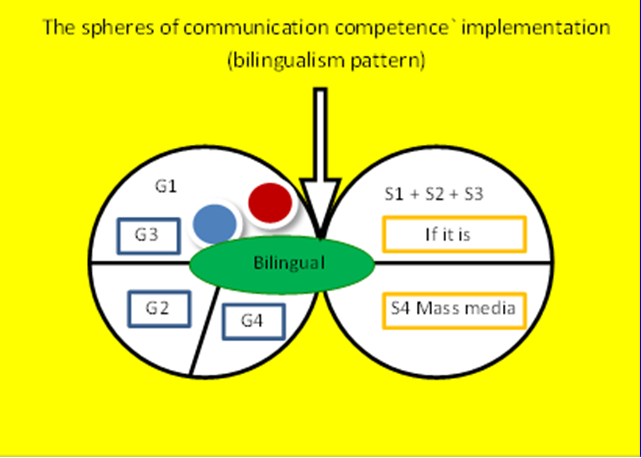
or
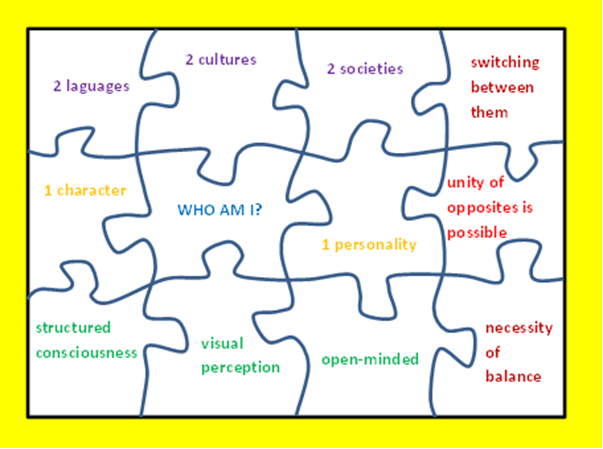
It becomes possible to implement under the influence of the following factors:
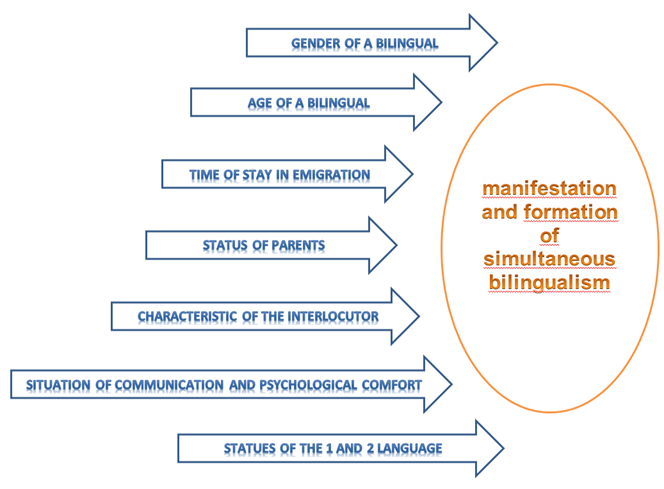
2) All these factors are implemented as a “triangle mutual safety integration”. Natural non
violent integration of bi-linguists and multi-linguists in societies carrying each language and culture is
possible only if each side of the triangle observes a balance in the ontological development of children
and adolescent.
Linguistic and media competencies (personal, social, and cross-cultural competencies) perform
instrumental roles such as, the signaling of the comfort and discomfort for bilingual and multilingual
communication situations, and self-presentation of possibilities in each language of the involved ethnic
culture.
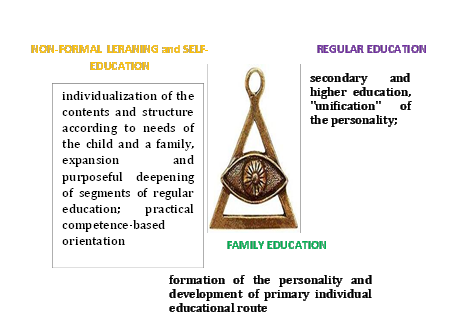
In quite a difficult situation, when a bi-linguist did not have an opportuinity to learn their own native
language; whether a Russian-speaking child lives in Europe or in a national Republic, for example, in
Tatarstan [4, 79] – with the help of various (often – gaming) technologies we try to organize the
educational process so that students will preserve their interest in ethno-cultural languages, so as to
create opportunities for the, to penetrate into the spiritual world of their nations. With this, the ability of
learning languages independently (to improve and measure their competencies, comparing them with
the needs of communication) is an important component of the students’ self-competence which will
promote his/her self-motivation.
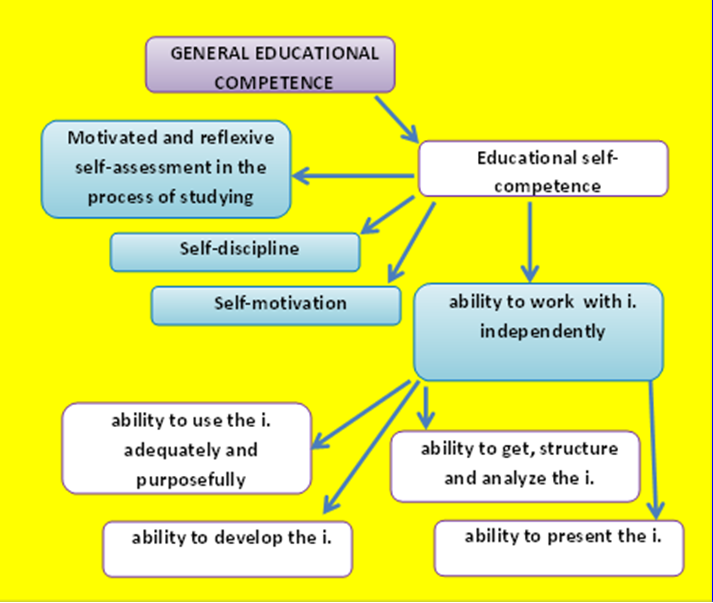
Main conclusions
Thus, our task is: firstly, to measure the students’ original knowledge, secondly, to motivate and
guide the transition of knowledge into skills, and afterwards use these skills in the process of
communication with representatives of various societies and ethnic-lingual-cultures (transition of skills
into competences).
Bulat Okudzhava said in one of his poems, "To understand each other is a sacred science", and
today this approach to communication becomes a vital necessity in everyday life, in the sphere of
science and education, in real space as well as in the virtual one". In an intention to listen and to
understand another person, the personal, social and cross-cultural competences become leading
components. In other words, the motivation for a balanced bilingual and multilingual personality of the
21st century Maslow's pyramid (fig.6) is as follows:
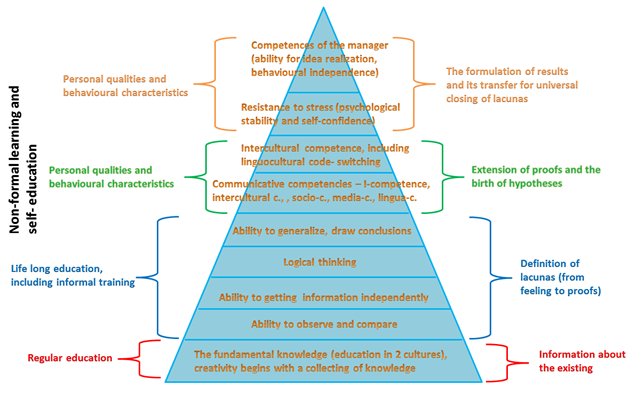
All these and several others problems can be solved by 4 products of our international network
laboratory "Innovative technologies in multicultural education". These are the results of
interdisciplinary projects related to diagnosing, support and development of balanced bilingualism and
inter-cultural competence in children aged 0-14.
As we have underlined, to achieve the goals we sought to use the most effective tools and
educational technologies. As a result, our products are: module interactive didactic materials (“Speech
palette: propaedeutic with logaoedic dominance”, “Fairy tales collection” developing Russian ethnic
culture foundations, interactive the “The preschool child's calendar portfolio” with children’s
development charts, “Complex diagnostic tests for bilinguals” with consideration of onto-genesis and
ethnic-lingual-cultural combination (from age to level) and «Road-Map-Bilingual» in 21 languages –
both for regular psychological and pedagogical support of a child and his/her family, and for research
activities.The products of our laboratory are unique, as they are preventive and diagnostic in nature,
and they implement an individual approach considering onto-genesis and ethnic-lingual-cultural
combination. They present a complex tool of preventive psycho-pedagogical support of a bi linguist –
from the initial diagnosing of bilingualism to formation of inter-cultural interaction and integration into
multicultural environment.In addition, these materials are being actively used not only when working
with bilingual and multilingual children, but also in pre-diagnostic exercising of foreign students,
particularly Turkmens, Uzbeks, Kyrgyz, studying Russian as a foreign language, as well as conducting
interviews with migrants taking certification exams. Countries of implementing these technologies are:
Russia, including the Russian President grant (1,500 preschoolers of Bashkortostan and Udmurtia);
Spain with the creation of the Spanish ethno-linguistic part, Czech Republic, Germany, Austria,
Lebanon, Estonia, Latvia, Egypt, Korea, Slovenia, Kazakhstan, Poland, Croatia, Ireland, Turkey,
Canada, Bulgaria, Australia, Greece.
Acknowledgments
Our sincere gratitude goes to the administration of Kazan Federal University and participants of our joint projects, in particular, Prof. T.I. Zelenina (Udmurt State University), Prof. L.K. Mazunova (Bashkortostan State Univ.), and methodists of Yelabuga kindergartens and our European colleagues.
References
Burt, M.K., Dulay, H.C., Hernandez-Chávez E.(1975). Bilingual Syntax Measure. New York: Harcourt Brace Jovanovitch.
Gumboldt, A. von.(1964). On the difference between the structure of human language and its influence on the spiritual development of the human race / V. von Gumboldt // Zvegintsev VA Readings on the history of linguistics XIX and XX centuries. – History of Linguistics XIX-XX centuries in the essays and extracts. Part I. -Moscow, 1964. - Ed. third, additional, 233-411.
Lonka, K. & Ketonen, E. (2012). How to make a lecture course an engaging learning experience? Studies for the Learning Society, 2-3, 63-74.
Koudrjavtseva, E. & Salimova, D., Snigireva, L. (2015). Russian as Native, Non-native, one of Natives and Foreign Languages: Questions of Terminology and Measurement of Levels of Proficiency. Asian Social Science; Vol. 11, No. 14. Published by Canadian Center of Science and Education.
Kozlov, N. Maslow’s Pyramid of needs. Available at: http://www.psychologos.ru/articles/view/piramida_potrebnostey_maslou.
Kudryavtseva, E., Zelenina, T., Utehina, A., Miftahutdinova, A., Bubekova, L., Salimova, D. (2014). Networking with international laboratories distributed participation as a form of multicultural education in Russia and abroad / Multilingualism in the edu-cational space: Sat. Art. Tom. 6 / Ed.: T. Zelenin, LM Small, NM Shutova. Izhevsk: Publishing house "Udmurt State University", 4-9.
Montrul, S. (2008).Incomplete Acquisition in Bilingualism. Re-examining the Age Factor / S. Montrul- Amsterdam: John Ben-jamins, 312 [Series on Studies in Bilingualism].
Ruismäki, H. &Tereska, T. (2006). Early childhood musical experiences: contributing to preervice elementary teachers’selfconcept in musicand success sin music education (duringstudentage). European Early Childhood Education Research Journal, 14(1), 113-130.
Salimova, D. (2012). Bilingualism in the Republic of Tatarstan: Criteria for Defining the Level of Language Proficiency and the Path to Bilingualism/ Municipal Education: Innovations and Experiments. 5, 78-80.
Salimova, D. (2014). Hope Johnson. Difficulties in the teaching of Russian as a foreign language: the perspectives of an ethnically Tatar specialist in Russian philology and an American student / Life Science Journal. 11 (5s), 11 (5s): 219-223. http://www.lifesciencesite.com 42
Yurkov, E., Lazareva, O., Popova, T. Language testing as a means of measuring the communicative competence of bilingual children. Available at: http://waucondastore.com/yazykovoe-testirovanie-kak-sredstvo-izmereniyakommunikativnoj-kompetencii-detej-bilingvov.
Complex diagnostic tests for German-Russian bilingual children aged 3-14: practical recommendations for testing bilingual children and adolescents (2015). Comp. Kudryavtseva, E. L., ed.; Kudryavtseva E., Timofeeva A., Danilova J., Salimova D., Bubekova L. Schöneichebei Berlin: Elena PlaksinaVerlag.
Individual road map your child’s development in the electronic format Road Map Bilingual (RoMB). Bilingual-Available at: http://bilingual-online.net. online.net/index.php?option=com_content&view=article&id=1600%3Aroad-map-bilingualromb&catid=68%3Adeti-mira&Itemid=60&lang=ru.
Copyright information

This work is licensed under a Creative Commons Attribution-NonCommercial-NoDerivatives 4.0 International License.
About this article
Publication Date
20 July 2016
Article Doi
eBook ISBN
978-1-80296-011-2
Publisher
Future Academy
Volume
12
Print ISBN (optional)
-
Edition Number
1st Edition
Pages
1-451
Subjects
Teacher, teacher training, teaching skills, teaching techniques, organization of education, management of education, FLT, language, language teaching theory, language teaching methods
Cite this article as:
Koudrjavtseva, E. L., Salimova, D. A., & Martínková, A. (2016). Innovative Tools for the Prevention of Psycho-Pedagogical Problems, for Bilinguals Aged 0 – 14 in the "Triangle of Mutual Safety Integration". In R. Valeeva (Ed.), Teacher Education - IFTE 2016, vol 12. European Proceedings of Social and Behavioural Sciences (pp. 96-102). Future Academy. https://doi.org/10.15405/epsbs.2016.07.16

